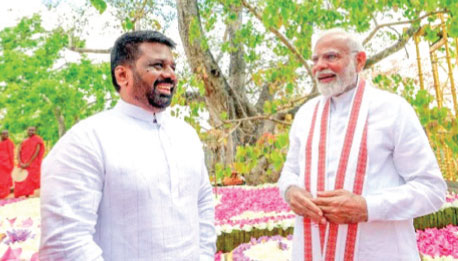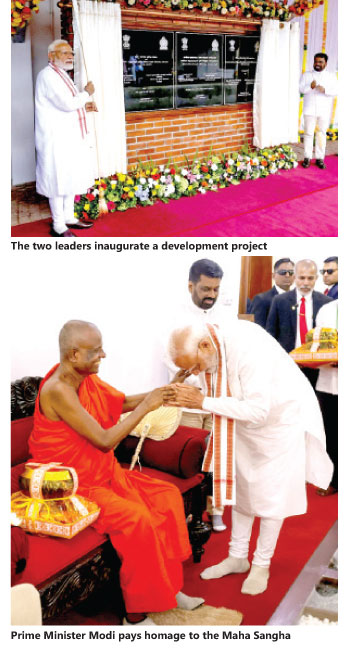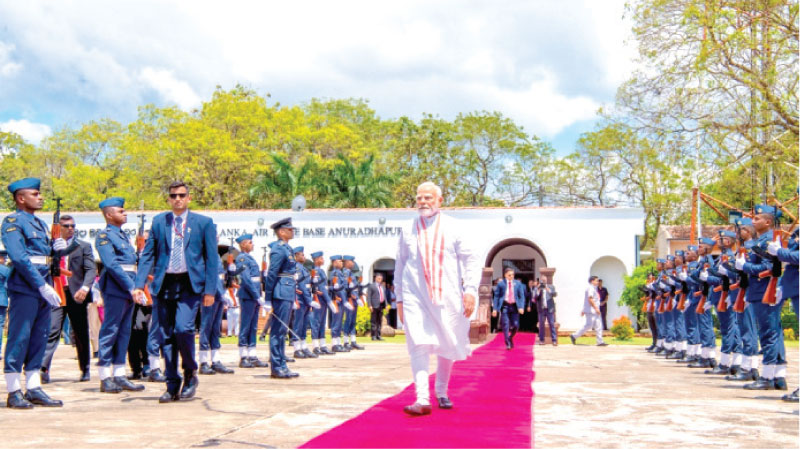Indian Prime Minister Narendra Modi’s visit to Sri Lanka (April 4–5) marked a pivotal moment in the bilateral relations between the two countries. He is the first foreign leader to visit Sri Lanka after the economic crisis and also since the new President, Anura Kumara Dissanayake, assumed office in September 2024.

The two leaders at the Jaya Sri Maha Bodhi in Anuradhapura
PM Modi reiterated Sri Lanka’s special place in India’s “Neighbourhood first” policy and “Vision Mahasagar”. Dissanayake, who made his first overseas visit to India in December 2024, also underlined the importance of the growing relationship between the two neighbours.
During Sri Lanka’s economic crisis, India had provided a US$ 4 billion financial assistance package, which included credit lines for essential imports, such as fuel, medicine, and food. India was instrumental in facilitating Sri Lanka’s discussions with the International Monetary Fund (IMF), securing financial aid worth US$ 2.9 billion for the island country. In an acknowledgement of PM Modi’s outstanding contributions to enhancing bilateral relations and fostering the shared cultural and spiritual heritage, Sri Lanka awarded him the esteemed Mitra Vibhushana Medal, the highest honour granted to foreign leaders and dignitaries.
Maritime security
In the realm of defence and security, India has consistently provided robust support to Sri Lanka. Given Sri Lanka’s strategic position and the rising influence of China in the Indo-Pacific, it plays a crucial role in regional maritime security, and India considers the island nation a vital ally in protecting its interests in the Indian Ocean Region (IOR).
The two countries have enhanced their collaboration in maritime surveillance, counter-piracy initiatives, and disaster relief operations. India has also offered to help Sri Lanka strengthen its naval capabilities.
India has also been providing support to Sri Lanka in bolstering its counter-terrorism apparatus, particularly after the 2019 Easter attacks, whose sixth anniversary is coming up next week. The recent Memorandum of Understanding (MoU) on Defence Cooperation will strengthen this partnership further. President Dissanayake also reassured PM Modi that Sri Lanka would not allow its territory to be used in a manner inimical to India’s security interests.
Apart from defence cooperation, Prime Minister Modi and President Dissanayake presided over the signing of several other MoUs aimed at bolstering multi-faceted collaboration. They include: The implementation of a High-Voltage Direct Current (HVDC) grid interconnection for the import and export of power, cooperation in digital transformation and health and medicine, and also in the development of Trincomalee as an energy hub in a tripartite pact involving the United Arab Emirates (UAE), India and Sri Lanka.
 India’s grant assistance will benefit the development of the famous Thirukoneswaram temple in Trincomalee, the Sita Eliya temple in Nuwara Eliya, the Sacred City Complex project in Anuradhapura, a World Heritage Site, and the upgrading of the Maho–Omanthai Railway Line project. Prime Minister Modi also announced a comprehensive capacity-building program in India covering 700 Sri Lankans from various sectors annually.
India’s grant assistance will benefit the development of the famous Thirukoneswaram temple in Trincomalee, the Sita Eliya temple in Nuwara Eliya, the Sacred City Complex project in Anuradhapura, a World Heritage Site, and the upgrading of the Maho–Omanthai Railway Line project. Prime Minister Modi also announced a comprehensive capacity-building program in India covering 700 Sri Lankans from various sectors annually.
A cornerstone of the visit was the inauguration of a 120-megawatt solar power plant in Trincomalee, which exemplifies Sri Lanka’s commitment to sustainable development and a strategic shift towards renewable energy sources.
The two nations discussed plans to improve power grid connectivity and investigate new ferry routes between Rameshwaram and Talaimannar to strengthen regional connectivity and promote economic integration.
Bilateral trade
India continues to be Sri Lanka’s leading trading partner. In 2024, the bilateral trade between the two countries exceeded US$ 5.5 billion. Both nations are actively engaged in efforts to lower trade barriers and enhance the exchange of goods. Additionally, India stands as Sri Lanka’s primary source of imports, playing a crucial role in the island’s economic recovery.
New Delhi has invested in various infrastructure projects as well, such as housing for displaced Tamils and efforts to rehabilitate areas impacted by conflict. Recently, India unveiled a support package worth approximately Rs 2.4 billion to promote social and economic growth in Sri Lanka’s Eastern Province.
India’s approach to its relationship with Sri Lanka offers important insights for Bangladesh and Nepal as they navigate their intricate geopolitical environments. They recognise the risks associated with China’s debt traps and are closely monitoring the outcomes of Sri Lanka’s economic recovery, particularly in light of India’s investments. (Indian Express)
The writer is associate professor, Centre for South Asian Studies, School of International Studies, Jawaharlal Nehru University









